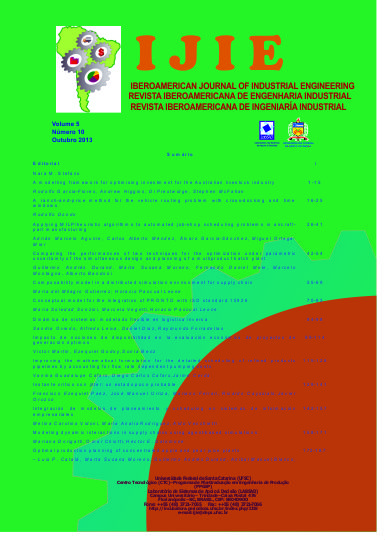A modelling framework for optimising investment for the Australian livestock industry
Palavras-chave:
Beef supply chain, Facility location, Network flow optimisation, Maximal coveringResumo
Despite the scale and importance of the beef industry in the north of Australia, recent political and environmental disruptions have highlighted the vulnerability of the supply chain. Ensuring that the supply chain remains resilient to climatic events as well as to unexpected decisions by the stakeholders will require careful planning and investment in logistics. In this paper, we outline an integrated methodology based on tactical and operational dynamic models, for assessing the effect of changes in the supply chain. Emphasis is on the development of an optimisation model that covers the flow of cattle from properties to agistment farms and feedlots to abattoirs/ports, and the selection of rest areas (spelling yards) along the path. The model selects the optimal location of spelling yards along the road network, subject to budget, site capacity, and service requirements. We show preliminary results for a case study comprising Western Australia and the Northern Territory. 10.13084/2175-8018.v05n10a01Referências
AGRICULTURE AND RESOURCE MANAGEMENT COUNCIL OF AUSTRALIA AND NEW ZEALAND. Standing Committee on Agriculture and Resource Management. Ed.: Land transport of cattle. Model code of practice for the welfare of animals SCARM report. CSIRO Publishing, 150 Oxford Street, Collingwood, VIC 3066, Australia, 1999.
AHUMADA, O.; VILLALOBOS, J. Application of planning models in the agri-food supply chain: a review. European Journal of Operational Research, v. 195, n. 1, p. 1-20, 2009.
BOYABATLI, O.; KLEINDORFER, P.; KOONTZ, S. Integrating long-term and short-term contracting in beef supply chains. Management Science, v. 57, n. 10, p. 1771-1787, 2011.
DOMINGUES-ZUCCHI, J.; ZENG, A.; CAIXETA-FILHO, J. Optimum location for export oriented slaughterhouses in Mato Grosso, Brazil: a dynamic mathematical model. International Journal of Logistics: Research and Applications, v. 14, n. 3, p. 135-148, 2011.
FOOD AND AGRICULTURE ORGANISATION. The technology challenge. Issues briefs, United Nations. 2009. Available at: <http://www.fao.org/fileadmin/templates/%20wsfs/docs/Issues%20papers/HLEF2050Technology.pdf./>
HIGGINS, A.; MILLER, C.; ARCHER, A.; TON, T.; FLETCHER, C.; MCALLISTER, R. Challenges of operations research practice in agricultural value chains. Journal of the Operational Research Society, v. 61, n. 6, p. 964-973, 2010.
KEARNEY, J. Food consumption trends and drivers. Philosophical Transactions of the Royal Society, v. 365, n. 1554, p. 2793-2807, 2012.
MCCOSKER, T.; MCLEAN, D.; HOLMES, P. Northern beef situation analysis. Technicalreport, Meat and Livestock Australia, Sydney, 2009.
MEATENG PTY Ltd: Evaluating the commercial viability of a northern outback. 2004. Queensland meat processing facility. Technical Report 136476698, Meateng Pty Ltd, 8 Montrose St., Hawthorn east, VIC 3123 Australia (February 2012) 11. Current, J., Daskin, M., Schilling, D.: 3. Discrete Network Location Models. In: Facility Location Applications and Theory, p. 81-118, 2004.
NATIONAL TRANSPORT COMMISSION AUSTRALIA. Guidelines for managing heavy vehicle driver fatigue. Final report, National Transport Commission Australia, Level 15/628 Bourke Street, Melbourne, VIC 3000, Australia, 2007.
STOTT, A.; LLOYD, J.; HUMPHRY, R.; GUNN, G. A linear programming approach toestimate the economic impact of bovine viral diarrhoea (bvd) at the whole-farm level in Scotland. Preventive Veterinary Medicine, v. 59, n. 1-2, p. 51-66, 2003.
STYGAR, A.; MAKULSKA, J. Application of mathematical modelling in beef herd management – a review. Annals of Animal Science, v. 10, n. 4, p. 333-348, 2010.
Downloads
Publicado
Como Citar
Edição
Seção
Licença
Os artigos publicados são de propriedade do IJIE – Iberoamerican Journal of Industrial Engineering, Revista Iberoamericana de Engenharia Industrial, Revista Iberoamericana de Ingeniería Industrial. Os autores são os responsáveis pelos conteúdos dos artigos. O IJIE não se responsabiliza ou endossa as opiniões emitidas pelos autores dos textos publicados, salientando que as opiniões são de exclusiva responsabilidade dos autores.
O periódico se reserva o direito de introduzir alterações no original, visando a manter a homogeneidade e a qualidade da publicação, respeitando, no entanto, o estilo e as opiniões dos autores. Essas alterações serão editoriais (correções gramaticais e adequações estilísticas) e não substanciais, de forma que não modifiquem o sentido do texto. As provas finais não serão enviadas aos autores, sendo o artigo publicado com os ajustes necessários.
Conforme citado neste site, no item “Caráter do IJIE”, os artigos são de uso gratuito, com atribuições próprias em aplicações educacionais e não-comerciais. Uma nova publicação do mesmo texto, de iniciativa de seu autor ou de terceiros, fica sujeita à expressa menção da precedência de sua publicação neste periódico, citando-se a edição e a data dessa publicação.

